The Shangri-Las |
|
THE SHANGRI-LAS - BRIEF OVERVIEW: |
|
"Four girls, out of Cambria Heights, who fell into my lap from the get-go, and I never realized how much talent I had on my hands. Mary and the others had the ability to make my stories believable. I don't know too many actresses out there who could do it. If you took them off the screen and told them 'By word alone, convince people,' they'd fail. The Shangri-Las were capable of pulling that off" - George "Shadow" Morton, Goldmine, 1991
"They say our stuff is corny, well a lot of people eat corn. Besides, if that were true, we wouldn't sell. Which we do. Our lines are realistic and frank" - Mary Ann Ganser, Village Voice, 1966
"They were tough girls. They really, really were" - Ellie Greenwich
"The rudest girls I ever met, absolutely disgusting" - Evie Sands
The Ronettes may have been the original bad girl group in rock and roll, but The Shangri-Las, affectionately known as The Shangs, embodied it. With their tight, leather outfits and slacks and slick go-go boots, these wild, gum-smacking, attitudinal, tell-it-as-it-is "Queens" who sang about dramatic teenage stories set to innovative records proved to be one of the most influential girl groups of all time.
They turned their producer, the eccentric-considered-genius George "Shadow" Morton (a noted rival of Phil Spector) into a legend and added more classic recordings to the stable of their primary songwriting team, the celebrated Jeff Barry and Ellie Greenwich. Artists as diverse as The Ramones, Amy Winehouse, Go-Gos, New York Dolls, Deborah Harry of Blondie, Lesley Gore, Dictators, Donnas, Joan Jett/ Runaways, Kim Gordon of Sonic Youth, and Bette Midler have all professed their inspiration from these "Myrmidions of Melodrama" as have lesser known artists such as The Pipettes, Faris Badwan of The Horrors, and Kathleen Hanna of Bikini Kill. The Beach Boys, Aerosmith, Louise Goffin (daughter of the legendary Goffin & King songwriting team), The Carpenters, Tracey Ullman, Skeeter Davis, Belle & Sebastian, and Melissa Etheridge are just some of the notable artists that have covered their work. The Shangri-Las left their mark on the British Invasion, glam rock, punk rock, and "goth rock" and its offshoots while influencing new generations of female artists and girl groups. They toured with The Beatles, The Rolling Stones, Chuck Berry, The Beach Boys, The Byrds, Dusty Springfield, Jan & Dean, The Supremes, Marvin Gaye, The Coasters, The Drifters, and The Zombies and even opened a show for James Brown. The Sonics and The Iguanas (the latter featuring a young Iggy Pop) once backed the girls on live engagements. Musicians such as the Beatles' Paul McCartney and Pete Townshend of The Who have praised their work, and they are one of the few white acts to win over black audiences (aside from charting records in the R&B market, they were popular on the R&B circuit). Their music has stood the test of time and has helped invest continued interest in Jerry Leiber & Mike Stoller's legendary Red Bird Records label.
The Shangri-Las' trademark street image style and talk-sing narration set often to woeful, teen angst-riddled records made them look hip, innocent, and sexy at the same time, and their highly choreographed, pantomime-like stage performances were engaging. Shadow Morton's penchant for sound effects and varied uses of instrumentation accompanying the sophisticated, teen melodramatic plots were equally effective. He incorporated screaming guitars, forlorn piano, jazz licks, breaking glass, operatic strings, revving motorcycles, and crying seagulls into his brilliant formula. While some detractors have labeled The Shangri-Las' music as over-the-top, campy soap operas, their reputations (as well as Morton's) have gained considerable strength over the years, even garnering the respect from noted music media figures such as Lester Bangs, John Peel, Greil Marcus, Robert Christgau, and Dave Marsh. After all, their unique style is what made them great in the first place. Artists such as Queen may have taken notes.
|
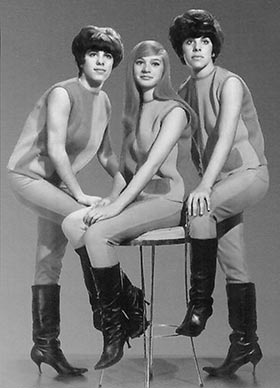
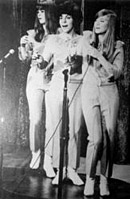
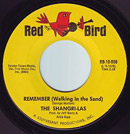
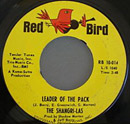
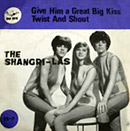
|
|
The Shangri-Las, comprised of two sets of sisters from the Queens borough of New York - Mary and Elizabeth (Betty) Weiss and the identical twins Marguerite (Marge) and Mary Ann Ganser, had interests in music at an early age and were influenced by Little Anthony & The Imperials and The Four Seasons. They started singing together in high school and by 1963 began playing at high school shows and teen joints in the New York area before piquing the interest of former Four Temptations member and songwriter/producer Artie Ripp of Kama Sutra Productions. Signed to the Mercury affiliate Smash, the girls cut the novelty rocker "Simon Says" b/w "Simon Speaks" (Smash1866) as The Shangra-Las, and the single was released in December of that year.
The next single release from the girls was shrouded in speculation for a lengthy amount of time. Some sources claimed that The Beatle-ettes' three 1964 singles "Yes You Can Hold My Hand" (Assault 1893), "Dance Beatle Dance" (Jamie 1270), and "Only Seventeen" (Jubilee 5472) were actually recorded by The Shangri-Las. Some sources also claimed that these girls recorded two singles under the name The Bon Bons that same year for the Decca division Coral: the wild driving rocker "Come on Baby" (Coral 64302) and their well-done cover of the Jackie DeShannon original "Each Time" (Coral 62435). The truth of the matter is that The Beatle-ettes were a different group, although Shadow Morton did write songs for them under the "B. Kelly" pseudonym, and that The Bon Bons were another girl group handled by Henry Jerome. But what never became a source of debate were the Weiss sisters' and the Ganser twins' early 1964 single "Wishing Well" on the Scepter subsidiary Spokane label (Spokane 4006), this time under the name The Shangri-Las.
"Wishing Well," The Shangri-Las' second 45, hinted at future productions of the group. There is a spoken intro bit by Betty before the song breaks into a driving beat and a great guitar solo, highlighted by twelve wishes that similarly echo Harvey & The Moonglows' all-time doo-wop classic "Ten Commandments of Love" (which was covered by Little Anthony & The Imperials). The song was a regional hit in the Northeast. The flip side, "Hate to Say I Told You So," also featured a spoken intro.
Around this time, an upstart songwriter named George Morton met with the Brill Building hit machine makers Jeff Barry and Ellie Greenwich, a husband and wife songwriting team that had great success with The Crystals, The Ronettes, and Darlene Love the previous year (Ellie had known Morton from a while back). Barry challenged Morton to produce a hit, and with determined gusto, Morton found backing musicians and eventually won The Shangri-Las over after seeing them perform a few times. The couple found potential with the enticing Shangri-Las and Morton's finished demo product, "Remember (Walkin' In the Sand)," which featured a young Billy Joel on piano, and made a deal with Jerry Leiber & Mike Stoller's Red Bird Records label. Leiber & Stoller had already become legends, producing hits for the luminaries Elvis Presley, The Coasters, and The Drifters. With The Shangri-Las and Dixie Cups under their belt, they would have a classic label as well.
"Remember (Walkin' in the Sand)" was released on July 20, 1964 and peaked at #5 US pop, #9 R&B, and #14 UK in the midst of the British Invasion. Haunting and nostalgic, the record consists of a doom-laden piano line and some surprising sound effects plunked down by Morton himself: a flurry of squalling seagulls and ocean waves striking the beach. The tempo change represents a flashback of lost romance and aligns itself with the oscillating tearful lead and subdued tone from lead singer Mary Weiss, accompanied by the doo-wopish, somewhat deadpan vocal delivery of the other singers. Aerosmith later covered this song to hit status with Mary Weiss providing backup vocals. The Beach Boys also recorded a version, and the song's influence can be seen on several records such as The Raspberries' track "On the Beach." An alternate take of "Remember," with a different intro and devoid of screeching seagulls, can be found on the 1969 Buddah compilation Incense and Oldies, which also features other Shangri-Las takes.
Strangely, this was the beginning of the groups' "shadow" fourth member, primarily regarding Betty. In the United States, the group, although officially a quartet, appeared more commonly as a trio. Even this presents more confusion. Sometimes the trio would consist of the Ganser twins and Mary Weiss, at other times the Weiss sisters and one of the Gansers. Several publicity shots would show all four members. "Remember (Walkin' in the Sand)'s" success also signaled the decades-long legal battle between Red Bird Records and Kama Sutra Productions over The Shangri-La's name, a very sensitive subject that the surviving girls to this day aren't comfortable talking about. Although the single cover to "Remember (Walkin' in the Sand)" showed The Shangri-Las clad in suburban attire, the girls were not happy with this traditional style; after all, they were raised in the tough New York City borough Queens. They looked for something more provocative, more subversive, and they found that by the time "Leader of the Pack" hit store shelves. The record's picture showed the girls in knee-high black boots and skin-tight gear. This cemented The Shangri-Las' image as the most dangerous-looking girl group and was the real start of their dark, bizarre, often-tragic teen mini-dramas.
The immortal "Leader of the Pack" was a worldwide chart winner, leading the charts in America and Australia and even reaching the US R&B Top 10. It became the definitive "death disc" and has since then become one of pop music's most influential recordings. Due to the violent nature of record, some radio stations in America refused to air the record, and the record was banned in the UK (it was still able to peak just outside the UK Top 10 at #11. It has since re-charted there a total of three more times, two times as a Top 10 hit, making The Shangri-Las the only American female group to hit the UK Top 20 three times).
The morbid tale of tragic teen romance begins with an (in)famous dialogue between Mary and the gang before the roaring of a motorcycle, the screeching of the brakes, and the sudden collision filled with breaking glass come into play, demonstrating Morton at his best. The song has become The Shangri-La's signature tune and was spoofed by The Detergents in "Leader of the Laundromat," which also struck the US Top 20. The line "Is she really going out with him?" later became a hit title for Joe Jackson, and the song was used as the title of a successful Broadway show centered on the songs of Barry & Greenwich. The song influenced producer Jim Steinman, known for his bombastic productions with Meat Loaf and Bonnie Tyler, and even The Ramones, whose "7-11" track, for example, follows a similar storyline. The single's success brought a spate of death records, most prominently The Whyte Boots' even more sinister "Nightmare." The record this time was penned by Barry & Greenwich and Morton, though conflicts have arisen as to who the real songwriters are.
In a bold move, Red Bird Records released two singles simultaneously in December 1964: the classic "Give Him a Great Big Kiss"and the double-header of covers "Maybe"b/w "Shout". "Give Him a Great Big Kiss" was bubbly and fun and a departure from the brooding nature of The Shangri-Las' previous records. The lines "When I say I'm in love, you best believe I'm in love, L-U-V" and "He's good-bad, but he's not evil" became famous. As a result of the single's success, Revlon cosmetics hired the girls to be their spokeswomen. "Maybe," with crowd noise added to give the impression that it was a live recording, was a cover of the classic Chantels record, and this demonstrated that The Shangri-Las could stay true to the hallmarks of the girl group sound. "Shout,"on the other hand, was a wonderful cover of The Isley Brother's legendary recording. By year's end, the trade magazine Cash Box named The Shangri-Las the number one new R&B vocal group. That's an incredible feat for four white girls.
Although The Shangri-Las' touring and media appearances were successes, including being featured on The Ed Sullivan Show, Where the Action Is, Shindig, Hullabaloo, Shivaree, Hollywood a Go Go, The Lloyd Thaxton Show, and The Soupy Sales Show, their visibility on the charts began to languish. The risqué but exciting "Out in the Streets" charted at #53 US pop in 1965 while the death disc "Give Us Your Blessings" (originally a hit by Ray Peterson) concerning eloping lovers in a somewhat modern Romeo-and-Juliet storyline barely scraped the American Top 30 (the A-side, "Heaven Only Knows," became a classic, once cited by Morrissey as his favorite recording and later covered by Red Kross). Nevertheless, both "Out" and "Give" became enduring pieces. The wonderful (and underrated) Motown-sounding "Right Now and Not Later" (co-written by the Motown songwriting/production team of Robert Bateman and Ronald Mosely) charted nationally at #99 pop. It was also around this time that The Shangri-Las had developed a wild reputation as rumors circulated that the girls were involved in gun smuggling, kidnapping, and other dark acts. They were also pegged for their un-ladylike behavior as demonstrated by their fondness for pool, considered a male sport in America at the time, and their sometimes bossy or volatile behavior. For example, when The Sonics, a noted garage band, backed The Shangri-Las on stage during a few occasions, leader Gerry Roslie commented on how bossy these sassy sirens were. The girls' documented pranks on Murray the K, Dick Clark, and Ellie Greenwich also added to their mystique.
Fall of 1965's "I Can Never Go Home Anymore" was The Shangri-Las' last Top 10 US hit, capping at #6 pop. It was also their last international hit, making strides in the UK and Japan. In this plodding tearjerker, the protagonist's mother dies of loneliness and heartbreak brought upon by her daughter. Mary's confessional voice drips with anguish as she relates the story in spoken monologue, accompanied by the pained intensity of the other girls. Her cry of "Mama" is at once touching and haunting. The protagonist's repentance at the end is as moving as the ending of the classic 1934 film Imitation of Life, where the conflicted daughter remorsefully sobs over her mother's casket. Perhaps the greatest feature of the record is its dramatic four-second string section, which comes in like a thunderclap. Written by Morton and arranged by Artie Butler (who arranged the hazy and eerie girl group classic "Sally Go Round the Roses" by the Jaynetts), the innovative leftfielder proved to be another classic. It's no wonder that Paul McCartney heralded this song as one of his favorites. Again, The Detergents answered with a parody in "I Can Never Eat Home Anymore" in 1966.
The bright "Long Live Our Love," with its "When Johnny Comes Marching Home" refrain, featured pipes and a brass band and fared well enough to make it into the US Top 40. The Shangri-Las also issued a busy, funereal cover of Jay & The American's "She Cried," re-titled "He Cried," and it settled unhappily as a near mid-charter in the States. Despite this, "He Cried" and its flip, "Dressed in Black," became classics.
Pete Townshend of The Who called "Past, Present and Future" (#59 US pop) one of the greatest singles of the '60s. Although the Harry Nilsson-penned b-side "Paradise" (also recorded by The Ronettes) was much more radio-friendly, the risky "Past" proved to be another leftfielder and even more cryptic and somber than "I Can Never Go Home Anymore." This time, any type of singing was obliterated. This seems to be a Mary Weiss solo number, accompanied by swirling strings and a piano set to a gloomy waltz. The striking use of Beethoven's "Moonlight Sonata" is brilliant, and the dance segment is the obvious climax of the record. Some have interpreted the song to be about rape or some type of physical or emotional abuse, but Mary confirms that the song is about one's desire to be isolated from everyone. No matter what the interpretation, "Past, Present and Future" is clearly an inventive piece.
Despite having many hits racked up, the Red Bird Records label was going under, facing financial difficulties. Marge had left the group in 1966, and Shadow relocated the remaining Shangri-Las to Mercury, where the group recorded two singles, 1966's psychedelic-laced "The Sweet Sounds of Summer" (#123 US pop) and 1967's national disaster, the pro-war (or more like pro-Vietnam war) song "Take the Time." With the abysmal failures of these records, the little royalty money the girls received, Marge's departure, and Shadow's direction geared more towards new acts such as Janis Ian and Vanilla Fudge (and later, with The New York Dolls and Mott the Hoople in the '70s), the group disbanded in 1968.
The Weiss sisters and Marge Ganser all married. Mary Ann sadly passed away in 1970 due to encephalitis (although other sources beg to differ). The three surviving girls made appearances on stage throughout the '70s, even performing at the legendary CBGB club in 1977. In 1989, they performed for the first time in a decade at an all-star oldies concert in New Jersey. Around this time, an imposter girl group using The Shangri-Las' name was found out by Betty, Mary, and Marge, and the original Shangri-Las sought legal action. In 1996, Marge succumbed to breast cancer, and this dealt as another blow to the girls and their fans. In March 2007, Norton Records issued the acclaimed Dangerous Game, a solo album by Mary Weiss, which featured a remake of "Heaven Only Knows." The album ended with seagulls and crashing waves, paying tribute to The Shangri-Las' breakthrough hit.
The Shangri-Las really lived up to their name, ironically. With "Shangri-la" being defined as an imaginary, idyllic place, akin to the earmarks of the girl group sound, the girls bridged this world with real life, tackling taboo subjects at times, likened to the often dark and brooding element of pure blues. This is what made them stand out from the hundreds of girl groups of their time.
The group had several other records that merit attention, such as their covers of The Ikette's classic "I'm Blue,"The Top Note's timeless "Twist and Shout," and The Slades "You Cheated (You Lied)". Noteworthy originals include the pounding "Sophisticated Boom Boom," the jazz-tinged Essra Mohawk composition "I'll Never Learn," and the faithful girl group numbers "Never Again" and "The Boy." Despite the passing away of its two members, the respect for these seminal yet underrated girls and Shadow Morton has greatly increased.
|
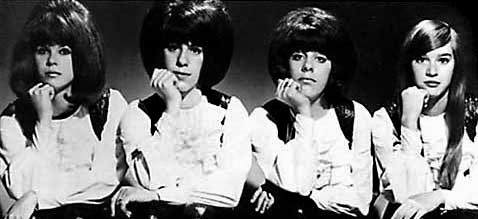
|
Shangri-Las
(left to right)
Betty Weiss,
Mary Ann Ganser,
Margie Ganser,
Mary Weiss
|
|
ALBUMS/TRACKS:
|
|
1. Leader of the Pack - 1965
1. Give Him a Great Big Kiss
2. Leader of the Pack
3. Bull Dog
4. It's Easier to Cry
5. What Is Love?
6. Remember (Walkin' in the Sand)
7. Twist and Shout
8. Maybe
9. So Much in Love
10. Shout
11. Goodnight, My Love, Pleasant Dreams
12. You Can't Sit Down
|
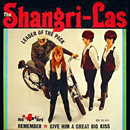
|
|
|
2. Shangri-Las 65! - 1965
1. Right Now and Not Later
2. Never Again
3. Give Us Your Blessings
4. Sophisticated Boom Boom
5. I'm Blue
6. Heaven Only Knows
7. The Train From Kansas City
8. Out in the Streets
9. What's a Girl Supposed to Do?
10. The Dum Dum Ditty
11. You Cheated, You Lied
12. The Boy
|
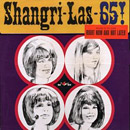 |
|
Selective Compilations
|
|
* Many labels have tried to create all-around wonderful compilations of the group, but many did not succeed. Here are the definitive documents that true Shangri-Las fans shouldn't be without.
• Myrmidons of Melodrama (1994)
• The Shangri-Las Remembered (2008)
• The Best of the Shangri-Las (1996)
|
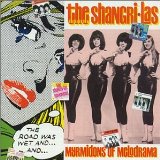
|
|
The Greatest Shangri-Las Songs
|
|
1. Leader of the Pack
2. Remember (Walkin' in the Sand)
3. Give Him a Great Big Kiss
4. I Can Never Go Home Anymore
5. Give Us Your Blessings
6. Out in the Streets
7. Long Live Our Love
8. He Cried
9. Past, Present and Future
10. Maybe
11. The Train from Kansas City
12. Right Now and Not Later
13. Heaven Only Knows
|
14. Sophisticated Boom Boom
15. Dressed in Black
16. Paradise
17. It's Easier to Cry
18. The Dum Dum Ditty
19. Never Again
20. The Sweet Sounds of Summer
21. What is Love?
22. What's a Girl Supposed to Do?
23. I'm Blue
24. Love You More Than Yesterday
25. Wishing Well
|
|
PLACEMENT ON DDD LISTS (as of 1/2009):
|
|
Shangri-Las
Greatest Female R&B/Soul Vocalists - #55 Mary Weiss
Greatest Female Vocalists of Rock - #114 Mary Weiss
Greatest Artists Of The 60's - #151
Greatest Girl Group Songs
- #9 Leader Of The Pack
- #16 Remember (Walkin' In The Sand)
- #76 Give Him A Great Big Kiss
Greatest Rock Songs of the 60's
- #196 Remember (Walkin' In The Sand)
|
|
|
